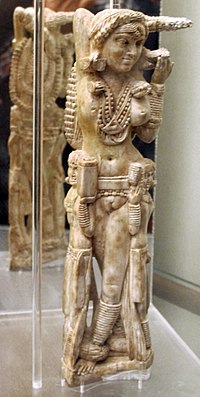User:Catsegura22/sandbox
This is where my article starts and how it will look:
Pompeii Lakshmi[edit]
· The Pompeii Lakshmi is an ivory statuette that was discovered in the ruins of Pompeii, which was destroyed in the eruption of Mount Vesuvius 79 CE. She was found by Amedeo Maiuri an Italian scholar in 1938.1 The statuette has been dated to the first-century A.D.2 The statuette is thought of representing an Indian goddess of feminine beauty and fertility. She has also been documented of being a possible mirror handle because of the indents and carvings in the material.3 Lakshmi is a reminder of commercial trade of goods and resources between India and Italy in the first century A.D. Over the years historians have been able to connect Roman trade with the far east specifically India.
The figure is now in the Secret Museum in the Naples National Archaeological Museum.4
------------
Contents[edit]
The statuette was discovered October 1938 beside the Casa dei Quattro stili at Pompeii. 5
Standing at 0.25 m. high the statuette is nearly naked apart from her narrow girdle and lavish jewels as well as an elaborate coiffure. She has two female attendants, one facing outward on each side, holding cosmetics containers.6 The statuette has a hole bored down from the top of her head. There is the theory that its purpose may have been a mirror handle.7
The existence of this statuette in Pompeii by 79 CE, when Mount Vesuvius erupted and buried the city, testifies to the intensity of Indo-Roman trade relations during the 1st century CE.[8][9]This statuette has been dated by the Naples National Archaeological Museum as having been created in India in the first half of that century.10
Trade[edit]
Though the origin is not entirely certain, based on archeological finds and historian work, the Pompeii Lakshmi has had a questionable origin. There is evidence of the then active trade routes between the Roman Empire under Emperor Nero and India during this time period.11 According to Pollard, with the Roman long-distance trade, she is believed to have found herself in the city during the reign of Augustus.12 The archeological evidence suggests that the height of trade between Roman and India appears to have been the first and second centuries C.E. This trade took place along several routes, both overland as documented by Isidore of Charax’s Parthian Stations, and by sea as the merchant guide known as the Periplus Maris Erythraei reveals. 13
Rome played an important part in the Eastern oriental trade of antiquity, they imported many goods from India and at the same time set up their own trading stations in the country.14 According to Cobb, trading through land routes such as crossing the Arabian Peninsula and Mesopotamia, and through seaborne trade from the Red Sea and the Indian Ocean were used by the Romans.15 The sea routes that utilized the winds of the Indian Ocean was able to create a significant volume of goods to be imported from the East on ships. The wealth of the trade was significant enough for Pliny to claim that 100 million sesterces were being sent annually to India, China, and Arabia.16 With shipments of nard, ivory, and textiles it is clear from the archaeological evidence, that Roman trade with the East peaked in the first and second centuries A.D.17
Iconography[edit]
The statuette is represented in the round, and the center of two other female figures. The legs are turned to its side and one arm bent to hold earrings. She is presumed to only be looked at front the front because the details from the back are very flat. As stated by D’Ancona, the iconography falls into the broad category of female deities in India.18 According to D'Ancona, the iconography represented in this statuette may have been imported from Classical world, possibly derived from the iconography of Venus attended by cherubs holding cosmetics containers, which are well known in Greco-Roman art. She may be one of the several representations of Venus-Sri-Lakshmi that appeared in the 1st century CE, states D'Ancona. 19 The Pompeii Lakshmi would therefore be a mixture of Indian and Classical art.20 An early relief from Sanchi Stupa No.2 with a broadly similar scene of Lakshmi with two child attendants may have served as the initial inspiration for the Pompeii Lakshmi, especially knowing that the Satavahanas were in control of Sanchi from 50 BCE on ward.21
References[edit]
1 An Indian Statuette from Pompeii, Mirella Levi D' Ancona, Artibus Asiae, Vol. 13, No. 3 (1950), pp. 166-180
2 J. J. “The Classical Weekly.” The Classical Weekly, vol. 32, no. 20, 1939, pp. 235–236.
3 “Abstracts of Articles.” The Classical Weekly, vol. 32, no. 18, 1939, pp. 214–215. JSTOR.
4 "Lakshmi". Museo Archeologico Napoli. Retrieved 4 February 2017
5 “Abstracts of Articles.” The Classical Weekly, vol. 32, no. 18, 1939, pp. 214–215. JSTOR.
6 Beard, Mary (2010). Pompeii: The Life of a Roman Town. Profile Books. p. 24.
7 “Abstracts of Articles.” The Classical Weekly, vol. 32, no. 18, 1939, pp. 214–215. JSTOR.
8 Beard, Mary (2010). Pompeii: The Life of a Roman Town. Profile Books. p. 24.
9 De Albentiis, Emidio; Foglia, Alfredo (2009). Secrets of Pompeii: Everyday Life in Ancient Rome. Getty Publications. p. 43.
10 "Lakshmi". Museo Archeologico Napoli. Retrieved 4 February 2017
11 Pollard, Elizabeth. "Indian Spices and Roman "Magic" in Imperial and Late Antique Indomediterranea*." Journal of World History 24, no. 1 (2013): 1-I.
12 Ibid. 7
13 Ibid. 7
14 Cobb, Matthew Adam. “THE RECEPTION AND CONSUMPTION OF EASTERN GOODS IN ROMAN SOCIETY.” Greece and Rome 60, no. 1 (2013): 136–52.
15 Ibid.
16 Ibid.
17 Ibid.
18 De Albentiis, Emidio; Foglia, Alfredo (2009). Secrets of Pompeii: Everyday Life in Ancient Rome. Getty Publications. p. 43.
19 Ibid.
20 Ibid.
21 Ibid.
This source is in another language
- Statuetta eburnea di arte indiana a Pompei, Maiuri p.112

